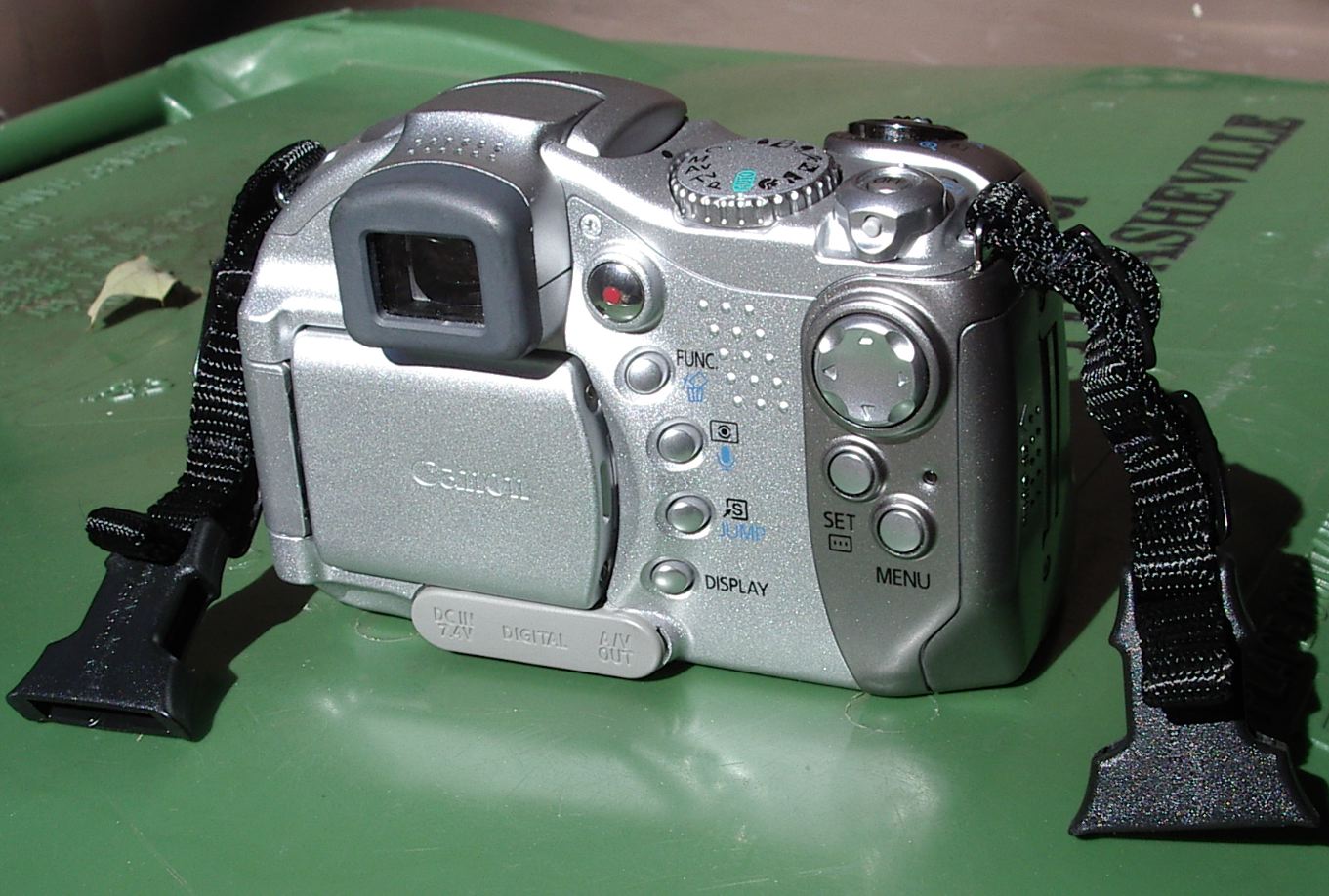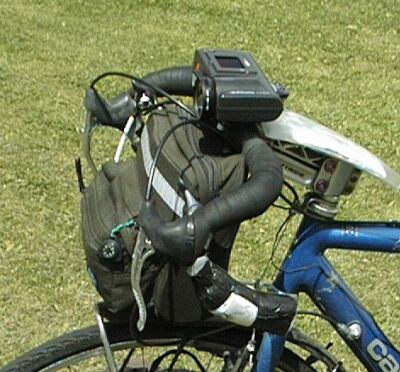
This is the fourth generation of my camera mount. All four were built using a piece of dense foam glued to a plexiglass base. The foam provided some cushioning and the base is attached to the handlebar using the mount from an old headlight. That mount was glued (using Goop) to the bottom of the base.
I've used a digital camera mounted on my touring bike's handlebars for the last six years. My first good digital camera, an Agfa 1280, was designed with an LCD monitor on the top of the camera body and a lens assembly that rotated through 180 degrees. I mounted the camera, with velcro straps, to a padded platform which I mounted to my handlebar. I could the use the display while riding to compose images.

When I wanted to replace that camera with a higher resolution camera - 3 Mega Pixel Casio QV- 3000 - I took a different approach. I got a conventional digital camera with a wide angle lens - 30 mm 35 mm equivalent - and learned to compose my images without being able to use the viewfinder or LCD monitor. Starting with a 3 MP image allowed me to use only a part of the original image when creating an images for use on my website.
I made two different, but similar, mounts for that camera. The first was, literally, ripped off on a return flight from Europe. Both mounted the camera upright on a platform mounted to my handlebar. The front of the camera was held in place by inserting its lens into a protective lens shade / filter holder I made from a plumbing pipe connector.
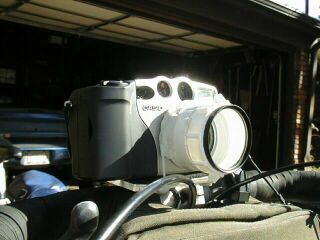
A piece of bent coat hanger wire glued to the lens shade and to the platform held things in place and the other ends of that wire came up behind the camera to keep it from coming out of the lens shade. This worked pretty well, but the camera was not held in place well enough to survive a crash or even a really rough road, so I also used the wrist strap to tether the camera to my handlebar bag. That camera survived two actual crashes and three other incidents where the riderless bike fell (or in one case was blown) over. In each case the camera came out of its mount and struck the pavement, but the impact was reduced by the tether.
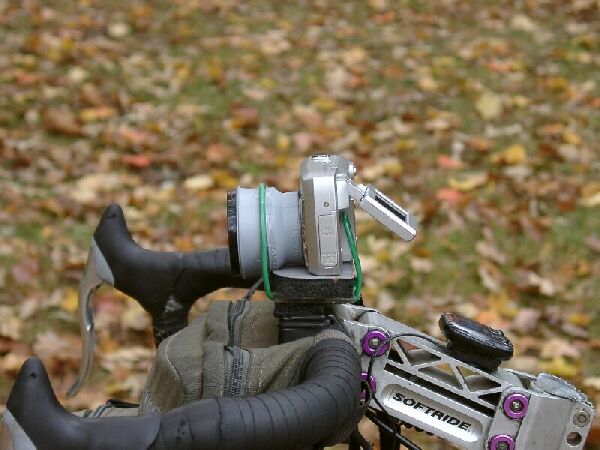
In the fall of 2003, I got a new, much smaller 3 MP camera. This camera (Pentax Optio 33L) has the same, conventional design as the Casio, but the LCD monitor swivels out from the camera body so that, as with the Agfa, I can compose while riding. It is smaller and lighter than the Casio and, using the same basic mount design, I have come up with a mount that should keep it in place even on rough roads. I'll still use the wrist strap as a tether, just in case...
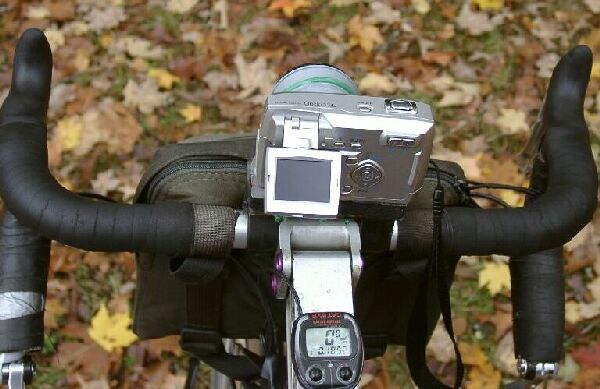
The Cockpit View

The Front View
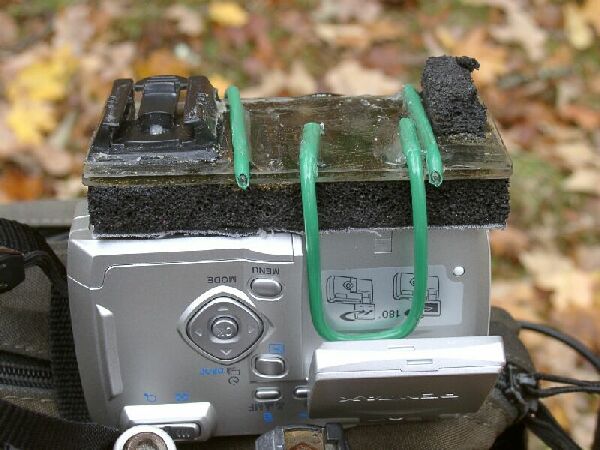
The Rear Bottom of the Mount
I use the same platform I used for the last version of the Casio mount. Since the first version of that mount was ripped off, I made this one easily removable. It mounts using the mounting bracket from an old headlight. The other side is supported by foam rubber that is rests on my current headlight mount on the other side of the handlebars. The green wire is cut from a coat hanger and Goop is used to hold all the parts together. The camera sits on a piece of thick foam rubber. The wire loop comes up behind the camera into the space where the LCD monitor can rest against the camera body.
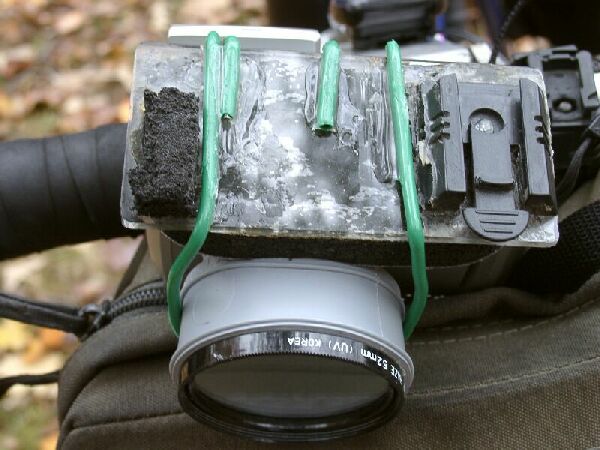
The Front Bottom of the Mount
The gray 'lens shade' is part of a 1 1/4" to 1 1/2" pipe connector. I could have used a 1 1/4" to 1 1/4" but I already had a filter which fit the 1 1/2" size, so I used this adapter. The 1 1/4" end is a tight fit on the part of the camera body that protrudes around the lens. The adapter is fexible and a bit stretchy, and it holds the camera body firmly. The lens shade, in addition to holding the camera in place, also protects the lens from water, dust, and road debris. The most vunerable part of most current digital cameras is the mechanism that entends the lens. My mount design keeps this part of the camera, and the lens itself, in a sealed environment.
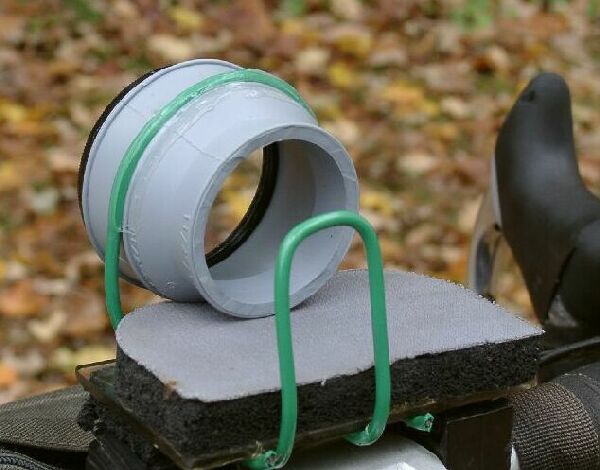
The Empty Mount
The new mount uses the same base as the previous mount. I just had to adapt my mount design to the camera. Since this camera has an LCD that can be rotated and swiveled up and away from the body. I have used the area where the LCD rests against the body for the back part of my mount. My first attempt, shown above, worked OK, but the LCD display would rotate down over bumps and the camera was not held very securely. I fixed both problems by making - from an asprin box, another small piece of plastic, and duct tape - a piece which fits into the back of the camera, holds the LCD up and makes the mount very secure. I've used that setupfor three thousand miles and it works very well!
Recently, I added a second kind of mounting adapter to my camera mount. This
makes it possible to mount my new Canon S1 IS camera if I remove the coat
hanger wires from the mount. Since the wires are attached with Goop, it
isn't difficult to remove them. I sucessfully used this mount with my S1,
but decided that, for use on a handlebar, the S1 had no advantage over the
Pentax 33L. Since the S1 weighs twice (!) as much as the 33L, I glued the
coathanger wires back to the base The mount with added Tamrac clips. One clip comes out horizontally on the
left hand side of the mount .
The Cannon S1 IS with Tamrac straps
I also made a, flexible plumbing adapter based, lens protector/filter holder
for the S1. I carried both the S1 and the 33L on my last tour because the
S1, which has a 10X zoom and Image Stabilization, is a better 'off
handlebar' camera than the 33L. If I lose or have problens with the 33L
while touring, I'll be able to mount the S1 in its place. As you can see,
those Tamrac straps could be used to mount any of the new, mini SLR style, digital
cameras to my handlebar camera mount.
Using a handlebar mounted digital camera has made a huge difference in both
the quality and quantity of images I take while touring. Look at the difference
between the reports for my first three long tours, where I rode without a handlebar
mounted digital camera, and the reports since '99 when I started using one. Both
my cameras and my skill at using them have improved a lot since '99, but even the
'99 web pages show the great improvement made possible by being able to
easily take pictures while riding.
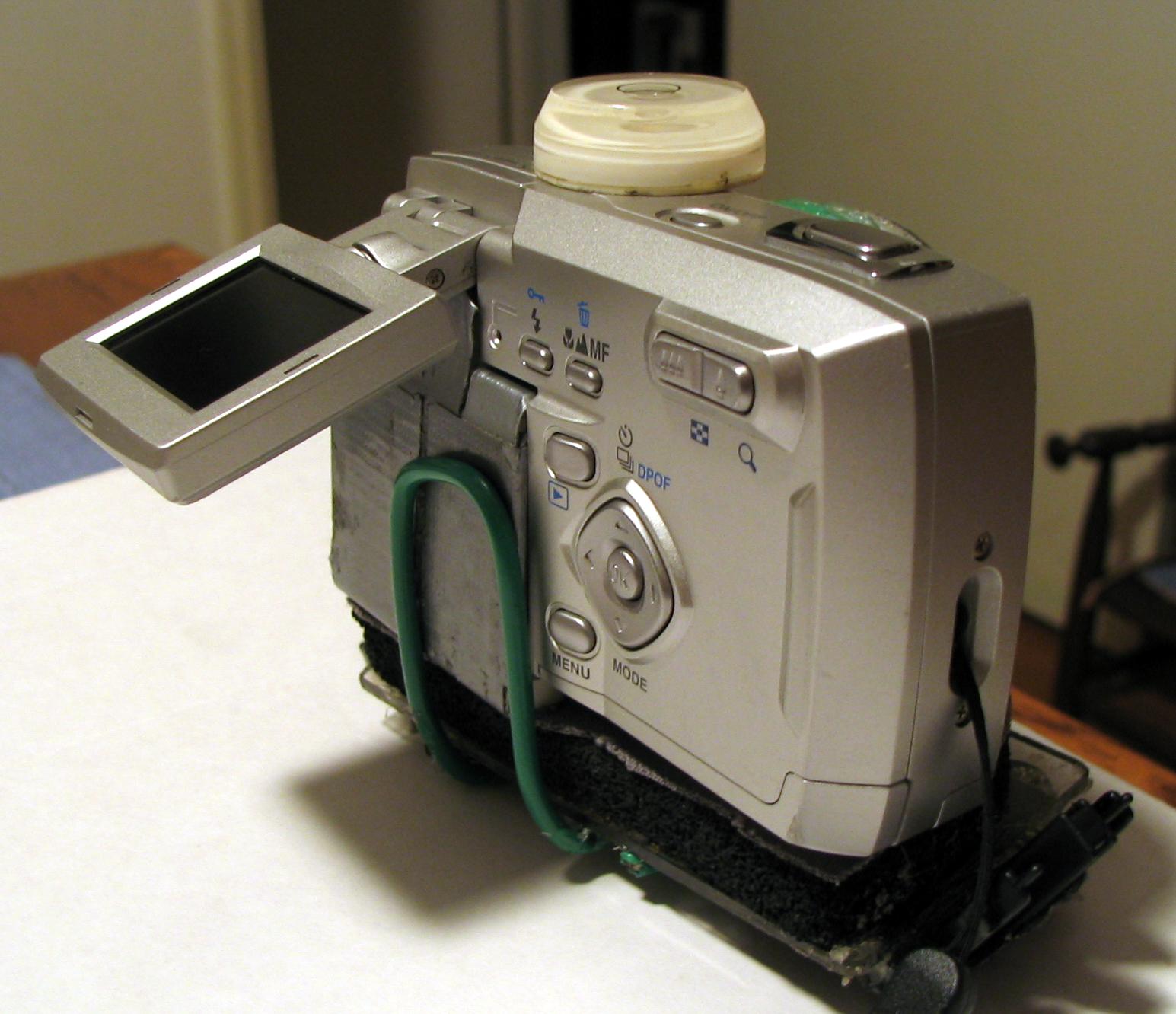
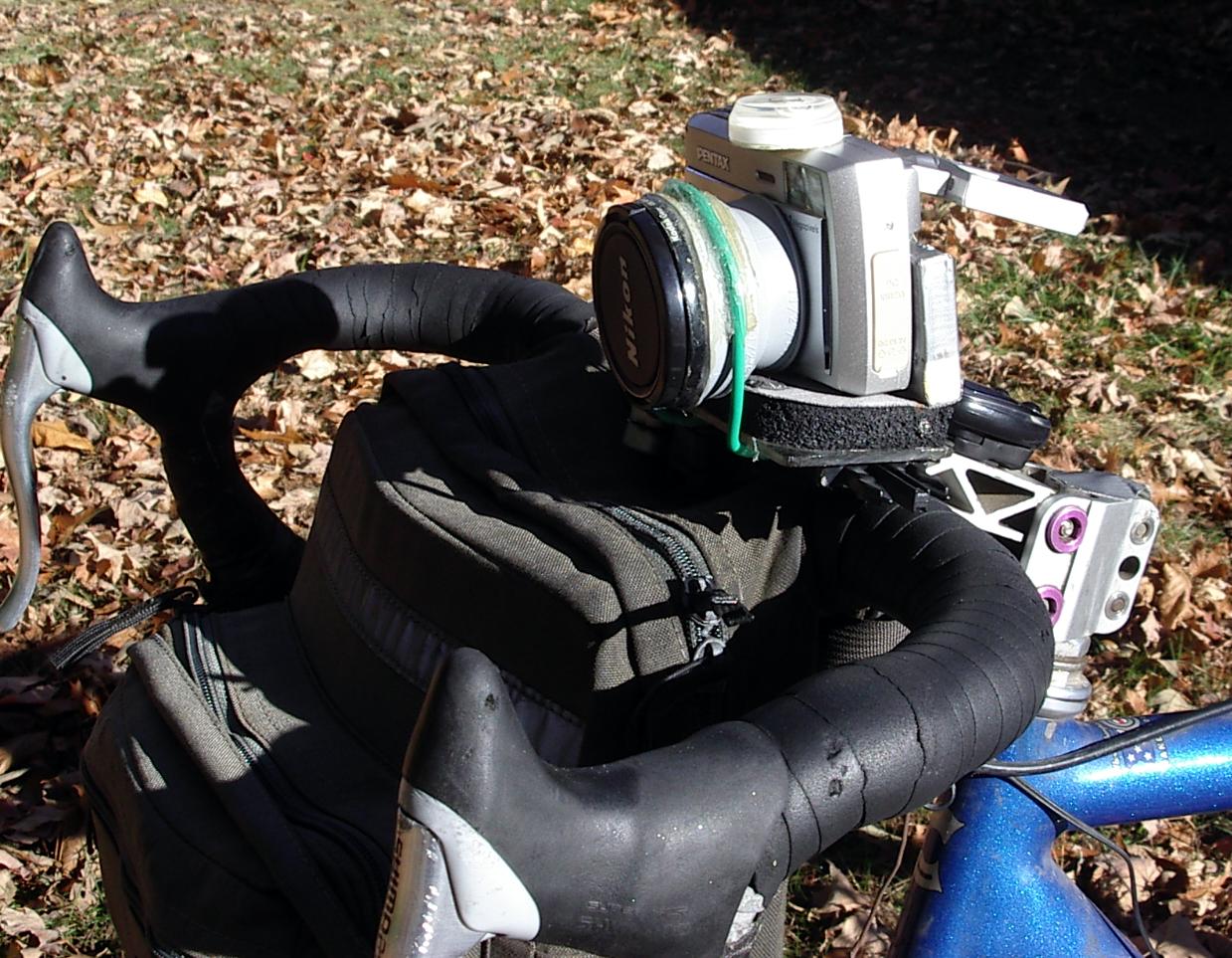
The other comes out at a 45 degree angle on
the right hand side 